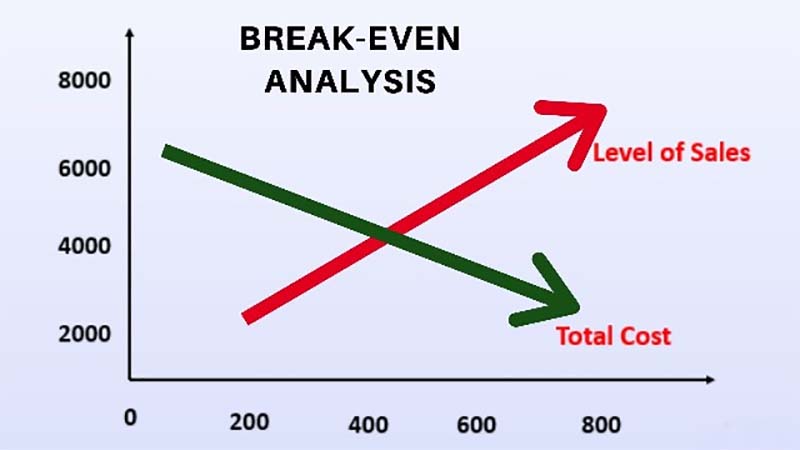I remember as a kid, there were so many fun and fair exhibitions and stalls to enjoy. As an adult, I see my friend hosting one. Stalls usually have a simple business model, where other than the product, the costs involved are of the stall and staff if any needed. My friend wrote down all the expenses from the rent of the stall to travel expenses on paper. She stated that she needs to make enough sales to recover the amount she put in the stall. Once she recovers the money invested by her, the rest of it is profit. Without realising, here she did a break-even analysis of her small business.
Read on further to understand break-even analysis in detail and use it for your business.
‘‘
To make smart business decisions, break-even analysis is an essential metric
Understanding break-even analysis
Any business, be it small or big, needs some amount of funds. In the initial years, any earnings would be first the recovery of funds. Once all the money you put in while starting the business is recovered, the rest is profit. The point of any business, where the costs incurred has been recovered but no profits have been made is known as the break-even point. As the business here is evenly broken, it is neither making profit or loss. Here the business is not making any money or losing any money. Any sales made after the break-even point is the profit of that business.
Even two companies who are selling the same products can have a different break-even point. If one company has Rs 50,000 as the total cost incurred and the second one has Rs 75,000 has the total cost incurred, the first company’s break-even point will be lower than the second one. This is because the cost incurred by the first company is less than the cost incurred by the second one. You can conduct a break-even analysis to understand the time taken to make your business profitable or the sales target needed to reach the no profit- no loss point.
When is break-even analysis used?
Break-even analysis can be conducted in your business at any point in time. Some of the common scenarios when businesses conduct a break-even analysis are
Establishing a new business
Break-even analysis is an excellent and efficient tool especially before starting a new business. It helps you to understand how viable is your idea and how realistic the costs are. It will help you to understand the financial forecast of your business idea. Also, it will help you as well as the investors to understand the sales needed to start making a profit. According to the break-even analysis, sales targets can be set according to how long the business can function with ease in the beginning without making any money. Break-even analysis of a new business will impact the cost-effectiveness, pricing strategy and also sales strategy.
Changing or transforming in the current business model
The key to surviving and sustaining any business is being open to changes. To have a competitive edge, you need to evolve as your industry does. During such times, when your business is going through an evolution, conduct a break-even analysis. As any amendments impact costs incurred and hence, the profits too. For example, a grocery store starts offering at-home delivery to get an edge over its competitors. Here the product price will remain the same, but the expenses have increased. A break-even analysis will help here in understanding the impact of this change on the business.
Launching a new product line
When you are planning to launch a new product, you need to consider the impact it will have on your business. Conducting a break-even analysis will reflect how the expenses incurred in the new product launch will affect your business. Sometimes, the fixed costs may remain the same and only changes may be observed in the variable costs. In that case, the analysis will help in understanding the impact of change in variable costs. Conducting an analysis aids in setting the price of the new product as its financial impact is already known before you start selling.
An additional sales technique
We live in the age of technology where sales techniques keep evolving and changing with technology now and then. Any additional sales technique or channel will impact the finances of any business. It may change the costs incurred by the sales department and also the sales. For example, an offline business that contemplates selling on Amazon needs to consider the fees charged by Amazon for their services. The significance of this new sales channel on your business can be known by conducting a break-even analysis.

Why should you perform a break-even analysis?
There are several situations where conducting a break-even analysis of your business would prove useful. Some perks of conducting break-even analysis of your business are
A break-even analysis in the simplest terms helps in determining the ability of your business to generate profit.
Break-even analysis of your business will help to tap the unleashed potential a product/service can generate. It will help you to utilise the unused capacity of your business and maximise its potential and profits.
It helps in determining the impact made on your profits due to the changes made in fixed costs or variable costs.
It helps in estimating the sales that are needed to be made to recover the costs.
It reflects how a change in price or sales impacts the finances of your business.
How to calculate the break-even analysis?
Break-even analysis is a great tool for your business and calculating it is relatively simple. The break-even point of your business equals your fixed costs divided by your average price derived after subtracting the variable costs.
In mathematical terms,
Break-Even Point = Fixed Costs/ (Average Price – Variable Costs)
Say a company is commencing its footwear line. The fixed cost incurred by the company is Rs 5,00,000. The average variable cost per unit is Rs 500. With a variety of footwear, the average price per unit is Rs 1000. Here the break-even point will be –
Break-even point = 5,00,000/ (1000-500) = 1000 units
This means that to recover the cost incurred, 1000 units are needed to be sold at a selling price of Rs 1,000 per unit. The 1000 units here is the break-even point.
Also, the break-even analysis included determining the contribution margin of a product. When you subtract the total variable cost from the selling price, the number derived is known as the contribution margin. Fixed costs are not considered while calculating the contribution margin of any product. For example, if the price of a product is Rs 500 and the variable cost is Rs 300 per unit, the contribution margin is Rs 200 (Rs 500 – Rs 300). The contribution margin of Rs 200 here is used to cover the fixed cost incurred.
‘‘
Break-even analysis of your business will help to tap the unleashed potential a product or service can generate
Limitations of break-even analysis
The break-even analysis does impact the decision making of any business. However, it has its limitations.
It fails to give the demand insights of the market as it does not reflect how likely your business is going to break even. As demand is not a stable and steady variant.
The break-even analysis would be difficult to conduct in huge corporations with multiple products at multiple prices.
While conducting the break-even analysis, you need to ensure that the data is accurate on your part.
The striking limitation of the break-even analysis is ignoring competitors. As competitors affect the market, prices, sales and demand of any product.
How can I lower my break-even point?
If after conducting the break-even analysis, you find that the units required to sell are too high, measures may be needed to lower the break-even point. In some scenarios, it might be unrealistic to lower the break-even point. While, in other cases with the application of the strategies below, the break-even point can be lowered –
Reducing the fixed costs
If you want to lower the break-even point of your business, a thorough analysis of your business is needed. See if you can reduce the fixed costs in any areas. For example, if there is ample space in your office that is not being used to its full capacity, consider subletting it or opting for a small office space. This will lower your fixed costs without impacting the production.
Increase the price per unit
If the selling price of your product is high, you may need to sell fewer units to break even. As the marginal contribution received by selling each unit increases. The catch here is to understand your target audience and their willingness to pay the price you are planning to quote. This strategy works the best if your product is not yet launched in the market. For an existing product, an upselling strategy may be needed as consumers may expect a better, upgraded version for the higher price.
Lowering your variable cost
Reducing the variable cost per unit is one of the most challenging strategies. One way to reduce the variable cost is increasing the scale of production if your business is ready for it. Also, negotiating with your supplier or considering other suppliers without compromising on the quality will help in reducing the variable cost. Even the process can be altered to make it cost-efficient like switching to cheaper alternatives for packaging.

To make smart business decisions, break-even analysis is an essential metric. The financial health of your business can be determined using it along with other metrics. Also, it is essential to monitor the break-even point of your business when any changes are made in the variable.




